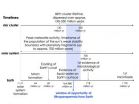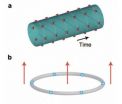(Press-News.org) Berkeley — When it comes to germ-busting power, the eyes have it, according to a discovery by University of California, Berkeley, researchers that could lead to new, inexpensive antimicrobial drugs.
A team of UC Berkeley vision scientists has found that small fragments of keratin protein in the eye play a key role in warding off pathogens. The researchers also put synthetic versions of these keratin fragments to the test against an array of nasty pathogens. These synthetic molecules effectively zapped bacteria that can lead to flesh-eating disease and strep throat (Streptococcus pyogenes), diarrhea (Escherichia coli), staph infections (Staphylococcus aureus) and cystic fibrosis lung infections (Pseudomonas aeruginosa).
The findings, to be published in the October issue of the Journal of Clinical Investigation, could lead to a powerful new weapon in the battle against disease-causing invaders. These keratin fragments are relatively easy to manufacture, making them good candidates for low-cost therapeutics, the study authors said.
"What's really exciting is that the keratins in our study are already in the body, so we know that they are not toxic, and that they are biocompatible," said the study's principal investigator, Suzanne Fleiszig, a professor at UC Berkeley's School of Optometry who specializes in infectious diseases and microbiology. "The problem with small, naturally occurring, antimicrobial molecules identified in previous research is that they were either toxic or easily inactivated by concentrations of salt that are normally found in our bodies."
These new small proteins in the study were derived from cytokeratin 6A, one of the filament proteins that connect to form a mesh throughout the cytoplasm of epithelial cells.
"We used to think that cytokeratins were primarily structural proteins, but our study shows that these fragments of keratin also have microbe-fighting capabilities," said study lead author Connie Tam, an assistant research scientist in Fleiszig's lab. "Cytokeratin 6A can be found in the epithelial cells of the human cornea as well as in skin, hair and nails. These are all areas of the body that are constantly exposed to microbes, so it makes sense that they would be part of the body's defense."
In a commentary published alongside the study, Michael Zasloff, professor of surgery and pediatrics at Georgetown University's School of Medicine, said these "keratin-derived antimicrobial peptides appear to be exciting new biocompatible candidates for development as human anti-infective therapeutics."
The researchers in Fleiszig's lab came upon cytokeratin 6A in their efforts to solve the mystery behind the eye's remarkable resilience to infection. They noticed that the surface of the eye, unlike other surfaces of the body, did not have bacteria living on it, and that corneal tissue could handily wipe out a barrage of pathogens in lab culture experiments.
"It is very difficult to infect the cornea of a healthy eye," said Fleiszig. "We've even used tissue paper to damage the eye's surface cells and then plastered them with bacteria, and still had trouble getting bacteria to enter the cornea. So we proposed that maybe there were antimicrobial factors that are unique to the eye."
In the hunt for this mystery compound, the researchers cultured human corneal epithelial cells and exposed them to the P. aeruginosa bacteria. They used mass spectrometry to sort out which peptides were most active in fighting off the bacteria. Cytokeratin 6A-derived peptides emerged the winners, and surprisingly, peptide fragments as short as 10 amino acids were effective.
To confirm that they got the right protein, the researchers used gene-silencing techniques to reduce the expression of cytokeratin 6A in the cornea of mice. With a key defense disabled, the amount of bacteria that adhered to the corneas increased fivefold.
Tests showed that cytokeratin 6A-derived fragments could quickly kill bacteria in water and in a saline solution, showing that the salt contained in human tears would not dilute the protein's effectiveness. Other experiments indicated that cytokeratin 6A fragments prevented the bacteria from attacking epithelial cells, and that the proteins cause bacterial membranes to leak, killing the pathogen within minutes.
The researchers noted that further research could reveal numerous different keratin fragments in the body's innate defense system.
"Keratins may represent a novel class of antimicrobials with the potential to be designed to selectively kill specific pathogens," said Tam.
###
Other study co-authors from UC Berkeley's School of Optometry are James Mun, a former UC Berkeley Ph.D. student, and David Evans, a UC Berkeley associate research scientist and a professor of biological and pharmaceutical sciences at Touro University California in Vallejo.
The Bill and Melinda Gates Foundation and the National Institutes of Health provided support for this research.
Study finds germ-killing power in the eyes
Discovery could lead to new antimicrobial drugs
2012-09-25
ELSE PRESS RELEASES FROM THIS DATE:
Princeton release: Slow-moving rocks better odds that life crashed to Earth from space
2012-09-25
VIDEO:
The researchers explored the likelihood that our solar system exchanged solid matter with its closest planetary-system neighbor during the first hundreds of millions of years it existed. At that time,...
Click here for more information.
Microorganisms that crashed to Earth embedded in the fragments of distant planets might have been the sprouts of life on this one, according to new research from Princeton University, the University of Arizona and the Centro de Astrobiología ...
New CU-Boulder study clarifies diversity, distribution of cutthroat trout in Colorado
2012-09-25
A novel genetic study led by the University of Colorado Boulder has helped to clarify the native diversity and distribution of cutthroat trout in Colorado, including the past and present haunts of the federally endangered greenback cutthroat trout.
The study, led by CU-Boulder postdoctoral researcher Jessica Metcalf, was based largely on DNA samples taken from cutthroat trout specimens preserved in ethanol in several U.S. museums around the country that were collected from around the state as far back as 150 years ago. The new study, in which Metcalf and her colleagues ...
Breast cancer treatment brings sexual difficulties for postmenopausal women
2012-09-25
CLEVELAND, Ohio (September 21, 2012)—Women treated for breast cancer after menopause with aromatase inhibitors have very high levels of sexual difficulties, including low interest, insufficient lubrication, and pain with intercourse. It is an important and underestimated problem, say the authors of a study published online in Menopause, the journal of the North American Menopause Society.
The researchers from Örebro University and Uppsala University in Sweden are the first to look at the impact of this type of breast cancer treatment on specific aspects of sexuality in ...
NASA's Chandra shows Milky Way is surrounded by halo of hot gas
2012-09-25
Astronomers have used NASA's Chandra X-ray Observatory to find evidence our Milky Way Galaxy is embedded in an enormous halo of hot gas that extends for hundreds of thousands of light years. The estimated mass of the halo is comparable to the mass of all the stars in the galaxy.
If the size and mass of this gas halo is confirmed, it also could be an explanation for what is known as the "missing baryon" problem for the galaxy.
Baryons are particles, such as protons and neutrons, that make up more than 99.9 percent of the mass of atoms found in the cosmos. Measurements ...
Melting Arctic ice cap at record
2012-09-25
Think of the poor hamster on the treadmill. Steadily picking up speed and caught up by the momentum, unable to stop until it is overwhelmed and sent tumbling, crashing out of control inside the spinning wheel.
That's the analogy John Yackel, head of the Department of Geography, makes when he considers the annual summer ice melt in the Arctic, which he's been closely monitoring for the past 15 years, documenting the ice cover as it has steadily shrunk in the wake of Arctic and global warming.
Last week marked the unofficial peak, or the end of the summer ice melt, ...
Automatic building mapping could help emergency responders
2012-09-25
CAMBRIDGE, MA -- MIT researchers have built a wearable sensor system that automatically creates a digital map of the environment through which the wearer is moving. The prototype system, described in a paper slated for the Intelligent Robots and Systems conference in Portugal next month, is envisioned as a tool to help emergency responders coordinate disaster response.
In experiments conducted on the MIT campus, a graduate student wearing the sensor system wandered the halls, and the sensors wirelessly relayed data to a laptop in a distant conference room. Observers in ...
A clock that will last forever
2012-09-25
Imagine a clock that will keep perfect time forever, even after the heat-death of the universe. This is the "wow" factor behind a device known as a "space-time crystal," a four-dimensional crystal that has periodic structure in time as well as space. However, there are also practical and important scientific reasons for constructing a space-time crystal. With such a 4D crystal, scientists would have a new and more effective means by which to study how complex physical properties and behaviors emerge from the collective interactions of large numbers of individual particles, ...
Viruses help MU scientists battle pathogenic bacteria and improve water supply
2012-09-25
Infectious bacteria received a taste of their own medicine from University of Missouri researchers who used viruses to infect and kill colonies of Pseudomonas aeruginosa, common disease-causing bacteria. The viruses, known as bacteriophages, could be used to efficiently sanitize water treatment facilities and may aid in the fight against deadly antibiotic-resistant bacteria.
"Our experiment was the first to use bacteriophages in conjunction with chlorine to destroy biofilms, which are layers of bacteria growing on a solid surface," said Zhiqiang Hu, associate professor ...
First-ever treatment for rare childhood aging disease shows improvement in all trial participants
2012-09-25
BOSTON, MA (September 24, 2012) – Results of the first-ever clinical drug trial for children with Progeria, a rare, fatal "rapid-aging" disease, demonstrate the efficacy of a farnesyltransferase inhibitor (FTI), a drug originally developed to treat cancer. The clinical trial results, completed only six years after scientists identified the cause of Progeria, included significant improvements in weight gain, bone structure and, most importantly, the cardiovascular system, according to The Progeria Research Foundation (PRF) and Boston Children's Hospital. The study results ...
Florida State University chemist may hold key to building a better toxin mousetrap
2012-09-25
TALLAHASSEE, Fla. — A Florida State University chemist's work could lead to big improvements in our ability to detect and eliminate specific toxins in our environment.
Featured on the cover of the prestigious Journal of the American Chemical Society (JACS), Sourav Saha's specialized work to strip electrons from the toxic chemical known as fluoride is producing a variety of unique results.
"I started out with the very basic premise of trying to find new ways to detect toxic fluoride in solutions," said Saha, an assistant professor of chemistry at Florida State. "As ...
LAST 30 PRESS RELEASES:
Many mothers in Norway do not show up for postnatal check-ups
Researchers want to find out why quick clay is so unstable
Superradiant spins show teamwork at the quantum scale
Cleveland Clinic Research links tumor bacteria to immunotherapy resistance in head and neck cancer
First Editorial of 2026: Resisting AI slop
Joint ground- and space-based observations reveal Saturn-mass rogue planet
Inheritable genetic variant offers protection against blood cancer risk and progression
Pigs settled Pacific islands alongside early human voyagers
A Coral reef’s daily pulse reshapes microbes in surrounding waters
EAST Tokamak experiments exceed plasma density limit, offering new approach to fusion ignition
Groundbreaking discovery reveals Africa’s oldest cremation pyre and complex ritual practices
First breathing ‘lung-on-chip’ developed using genetically identical cells
How people moved pigs across the Pacific
Interaction of climate change and human activity and its impact on plant diversity in Qinghai-Tibet plateau
From addressing uncertainty to national strategy: an interpretation of Professor Lim Siong Guan’s views
Clinical trials on AI language model use in digestive healthcare
Scientists improve robotic visual–inertial trajectory localization accuracy using cross-modal interaction and selection techniques
Correlation between cancer cachexia and immune-related adverse events in HCC
Human adipose tissue: a new source for functional organoids
Metro lines double as freight highways during off-peak hours, Beijing study shows
Biomedical functions and applications of nanomaterials in tumor diagnosis and treatment: perspectives from ophthalmic oncology
3D imaging unveils how passivation improves perovskite solar cell performance
Enriching framework Al sites in 8-membered rings of Cu-SSZ-39 zeolite to enhance low-temperature ammonia selective catalytic reduction performance
AI-powered RNA drug development: a new frontier in therapeutics
Decoupling the HOR enhancement on PtRu: Dynamically matching interfacial water to reaction coordinates
Sulfur isn’t poisonous when it synergistically acts with phosphine in olefins hydroformylation
URI researchers uncover molecular mechanisms behind speciation in corals
Chitin based carbon aerogel offers a cleaner way to store thermal energy
Tracing hidden sources of nitrate pollution in rapidly changing rural urban landscapes
Viruses on plastic pollution may quietly accelerate the spread of antibiotic resistance
[Press-News.org] Study finds germ-killing power in the eyesDiscovery could lead to new antimicrobial drugs




